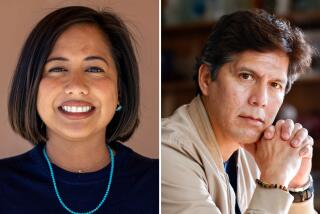City Denies Koreatown Residents’ Demand for Council District Status
- Share via
The City of Los Angeles has rejected a demand by Koreatown residents to be placed in a single City Council district, contending that the fast-growing ethnic community is still too small to influence the outcome of political contests and warrant the same protection as Latinos under the federal Voting Rights Act.
The rejection was contained in papers filed by City Atty. James K. Hahn in federal court this week defending the council redistricting plan approved by the council July 31.
That plan created a district tailored for the election of a second Latino in central Los Angeles, but at the expense of two council members, John Ferraro and Michael Woo, who would be thrown into the same Hollywood-Wilshire district and would be forced to run against each other.
At the same time, private talks continued at City Hall on an entirely new redistricting plan that would avert a Woo-Ferraro clash by placing each in separate districts, while leaving intact the provision for a new Latino district. That would be done by giving much of the present 1st District in East San Fernando Valley, which had been represented by the late Councilman Howard Finn, to Councilmen Ernani Bernardi and Joel Wachs. Part of their districts would be assigned to Woo.
With the new plan gaining momentum in City Hall, the city attorney’s office found itself in the unusual position of going to federal court to defend the earlier plan, even though some council members want to abandon it. Explaining why, Assistant City Atty. Shelley Rosenfield said the city must “vigorously defend” the first plan in case the council does not approve a new one.
The council redrew its district lines to settle a U.S. Justice Department suit contending that the old boundaries deprived Latinos of political influence by splitting their neighborhoods among several districts in violation of the Voting Rights Act. A hearing is scheduled tentatively for Sept. 8 before U.S. District Judge James M. Ideman on challenges to the plan.
Koreans challenged the plan in court earlier as violating their voting rights by splitting Koreatown among three districts--the 4th, 8th and 10th.
Hahn, in the city’s response, said the population of Koreatown is too small to make a difference politically even if united in a single district. He pointed out that under the Voting Rights Act, “a minority group cannot complain about vote dilution where its numbers are too few or too dispersed to be an effective majority.”
Throughout Los Angeles County, the Korean population has jumped from 9,000 in 1970 to estimates of 150,000 to 300,000 today. But the city’s Koreatown, with 40,000 residents, could “at best” make up 20% of a single district’s total population of 200,000 residents, Hahn said.
“This falls far short of the number necessary to constitute an effective majority,” the city attorney said. “Since these Koreans could not be effective in one district, it is no violation of the Voting Rights Act to place them in two, or three or more districts.”
Hahn also responded to a demand by the Justice Department and the Mexican American Legal Defense and Education Fund for a special election in a new, predominantly Latino district.
He said the group’s demands for Ferraro to be placed in the new district because he is up for reelection next year could backfire. Noting that Ferraro is a “well-known and powerful political figure,” Hahn said, “it would be a serious undertaking for a Hispanic newcomer to a challenge a man of Ferraro’s stature.”
More to Read
Sign up for Essential California
The most important California stories and recommendations in your inbox every morning.
You may occasionally receive promotional content from the Los Angeles Times.











